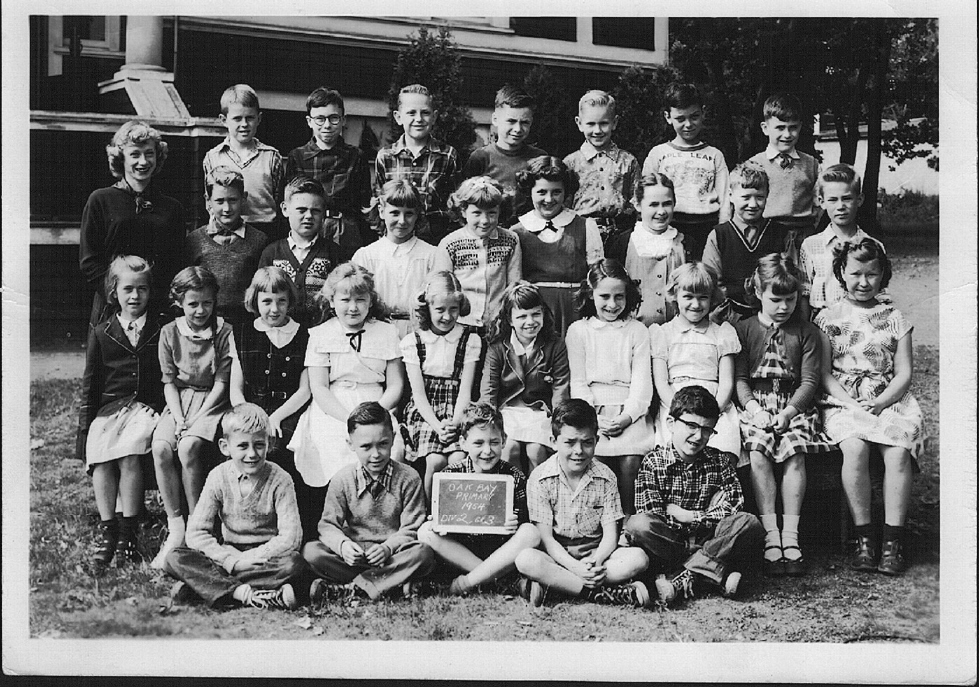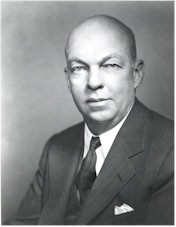




This is Gerry's grade 3 class. Now what is a grade 3 photograph doing in a high school site? The connection is that very many of these little faces kept moving through the educational system of Oak Bay and emerged onto the high school scene. A substantial number appears in the School Life pages of this site. No cheating now. Scroll the key below off the screen and then see how many of these kids' names you can guess!
Here's the old Oak Bay Elementary in the background.

Back row: little Roddy Clayards, Ian Wickett, little Eddy Bell, Bob Clements, little Jimmy Ogilvie, Bob Hale, Ken Hart.
Third row: Moly Mergens, Richard Johnston, little Gerry Hagberg, Eileen Mellors, Donna Burrows, little Patsy Morrison, Amity Turnbull, little Bobby Thompson, little Donny Squires.
Second row: Heather Kern, Dianne McNaught, Pat [somebody], [unknown yet], Bonnie Craig, Wendy Stevens, Cheryl Borris (This girl is NOT Cheryl Borris. Cheryl did not attend Willows until grade 5. The fact is, Cheryl says, her photograph is nowhere on the site. Well, Gerry and the webmaster did try! (Cheryl Borris 030128).), Linda Moretti, Betty-Lou Greenwood
Front row: [somebody], Alan Blackwell, [somebody], Harold Sutton(?), David Shore.
These kids weren't paying attention and most of their parents weren't either but it was in this year that William Golding's Lord of the Flies appeared. By the time we were in grade 12, the novel had been made into a film.
Charlie Mingus, a "name" by the time these kids entered university, formed his first group in this year.

This man, Edwin H. Armstrong, died. His passing marked the change of radio electronics from vigorous, obstreperous youth to cynical, businesslike adult.
You do not own a radio or television receiver that does not contain circuitry principles set out by this engineer. For the slightly more technical, Armstrong understood the phenomenon of feedback very early, when others did not, and he introduced it into common design practice. In 1918 he set out the fundamental idea of the superheterodyne radio receiver. Among other innovations, that of frequency modulation belongs to Armstrong.
Armstrong was an honest, forthright engineer who was taken advantage of by big business and by a legal system the operators of which were resolute in maintaining their technical ignorance. It was only after his tragic death that he was properly credited and even that took many years of effort. The technical, if not the legal, community had stood by Armstrong all along and he was eventually vindicated in courts.
If you enjoy biography and you would risk the elevation of your level of cynicism, read about Edwin H. Armstrong. When you have read Armstrong's biography you will have gained an insight into why those of us in radio-electronics hold the silk suits in the corner offices in such opprobrium.
Armstrong's life includes one further high distinction: he was one of Nikola Tesla's (Никола Тесла ) pall bearers. Tesla was borne to his final rest by, among others, Armstrong and Alexanderson.
In 1954 segregation was banned in the U.S. Next year, Rosa Parks, tired out after an honest day's work, will refuse to give up her seat in a 'bus and will touch off a series of news stories that were part of the fabric of everyday life all through our elementary and high school years. The outcome is a part of the world view of us children of the 'sixties.
You will be just old enough to remember Diên Biên Phu being in the news every day. After months of superhuman feats, man hauling artillery pieces through roadless mountains, General Giap's forces invested Diên Biên Phu, garrisoned by the equivalent of a full division as well as two independent regiments of French. in northwestern Vietnam. After a hideous 56 days, the French surrendered on May 7, 1954.
Convair delivered the last of 385 B-36 bombers. The B-36 was that "S.A.C. bomber" that we all knew in these years. Many were its technical shortcomings. Here's trivia for you: jet engines installed on the "D" variant and later did not burn JP-4 but gasoline! Next year Jimmy Stewart will appear in a propaganda film about S.A.C. built around the behemoth B-36. For aviation buffs: the B-36 with its six piston engines and those four gasoline fuelled turbines, when sitting at the end of the runway with takeoff check list completed, was then reported to be ready for takeoff with "six turning and four burning". Watch a take off.
The film also introduced the B-47. Again, for electronics buffs, the B-47 has a part in radio history. Ham radio operators had investigated single side band suppressed carrier operation (still mode A3j to some of us) before the second war and in the late forties and early fifties it was finding wide acceptance among amateur radio operators. Even though with the circuitry of the time, s.s.b.s.c. required much "plumbing" and fiddling about, the hams knew that it was worth the effort. By 1954, sideband technique was a commonplace on the ham bands.
An experienced radio operator, with Morse technique, could work the world from an aircraft but the new B-47 was going to be too small to carry a radio operator (the B-36 had carried two radio operators!). Curtis LeMay was a ham radio operator and realized that his pilots, if equipped with this single side band equipment now being used by hams, would be able to have long distance communication even without a radio operator aboard. LeMay recruited fellow hams for testing. In 1956 test flights to Greenland and to Okinawa proved that the equipment then already commonly in use by ham radio operators was far superior to the "sophisticated" a.m. equipment that the military persisted in using.
On Saturday, August the 7th of this year an event that was the first enduring memory of television for many of us happened in Vancouver. In May, Roger Bannister had run a four minute mile. For 30 years the track world had speculated on the possibility and this year it happened. No sooner had Bannister become world famous for his feat than John Landy of Australia bettered Bannister's time by the astonishing margin of two seconds. In the British Empire Games at Vancouver the two would meet.
In preparation for the games, the new C.B.C. television station in Vancouver, CBUT, had invested in what was then an astonishing piece of equipment, a Zoomar lens. Turret lenses were the standard of the time on television cameras, of course, exactly the same arrangement as motion picture cameras had had. The Zoomar was news and CBUT made a special presentation at the brand new, empty, Empire Stadium to show off what viewers could expect from the lens during the games! A slim, fresh faced young Ted Reynolds stood out in the middle of the field, microphone in hand. A television camera located high in the press section at the top of the stands at the south end of the brand new, huge, Empire Stadium centred him in the middle of a wide angle shot. As Reynolds extolled the new technology, the lens was slowly zoomed in upon him.
![]()
